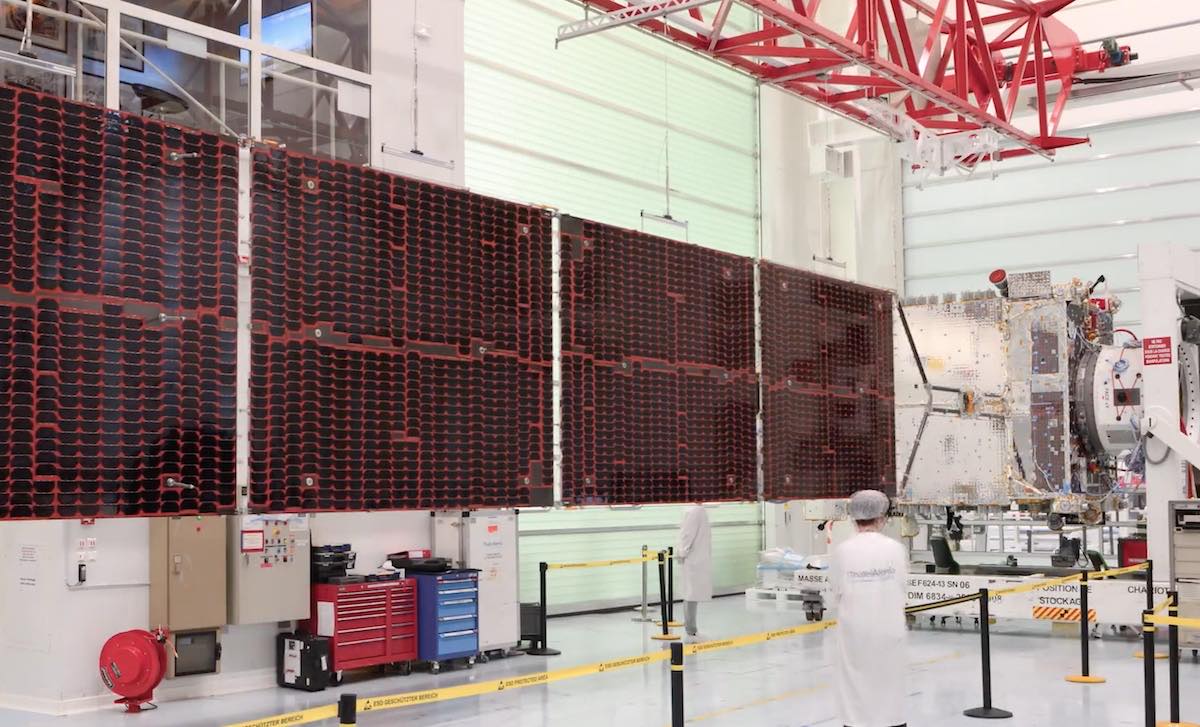Live coverage of the countdown and launch of a SpaceX Falcon 9 rocket from Space Launch Complex 40 at Cape Canaveral Space Force Station, Florida. The Falcon 9 rocket will launch the Egyptian Nilesat 301 communications satellite. Follow us on Twitter.
SFN Live
SpaceX’s next launch will deploy a telecom satellite for Egypt’s Nilesat after liftoff of a Falcon 9 rocket Wednesday afternoon from Cape Canaveral. The Falcon 9 is scheduled launch with the Nilesat 301 telecom payload during a window opening at 5:04 p.m. EDT (2104 GMT).
The 229-foot-tall Falcon 9 rocket is set to blast off from pad 40 at Cape Canaveral Space Force Station in Florida, beginning a 33-minute mission to place the roughly 9,000-pound (4.1-metric ton) Nilesat 301 spacecraft into an elongated transfer orbit ranging tens of thousands of miles above Earth.
Nilesat 301 is destined for an operating position in geostationary orbit more than 22,000 miles (nearly 36,000 kilometers) over the equator at 7 degrees west longitude, where it will provide TV broadcast and internet services over Egypt and other parts of Africa and the Middle East. The spacecraft will use its own propulsion system for the final maneuvers to reaching its operational orbit.
The launch Wednesday will be the 23rd Falcon 9 launch of the year, and the first with a satellite heading toward geostationary orbit, a popular location for TV broadcasting and data relay spacecraft. It’s also the first truly commercial launch into a geostationary transfer orbit worldwide this year.
The geostationary satellite launch market was once a lucrative business for launch providers, including SpaceX. But the satellite market has shifted to smaller spacecraft, including constellations flying in lower-altitude orbits, to beam broadband signals to consumers.
SpaceX operates the Starlink network, the world’s largest fleet of satellites, and other companies are in the process of developing and deploying their own constellations.

Nilesat 301’s launch is the first of up to six Falcon 9 rocket flights scheduled for June.
SpaceX will load a million pounds of densified, super-chilled kerosene and liquid oxygen propellants into the Falcon 9 in the final 35 minutes of the countdown Wednesday. The Falcon 9 will transition to internal power and pressurize its propellant tanks before igniting nine Merlin main engines at T-minus 3 seconds.
After passing an automated health check, computers will command four hold-down clamps to open, clearing the way for the Falcon 9 lift off from pad 40 with 1.7 million pounds of thrust.
Launch time is set for 5:04 p.m. EDT (2104 GMT) Wednesday at the opening of a 2-hour, 29-minute window. Forecasters from the U.S. Space Force predict a 60% chance of favorable weather for launch Wednesday, with the primary concern associated with threatening clouds from nearby thunderstorms.
Once it departs the pad, the Falcon 9 will arc toward the east from Cape Canaveral over the Atlantic Ocean and exceed the speed of sound in about one minute. The first stage booster will shut off its engines and separate from the Falcon 9’s upper stage at T+plus 2 minutes, 37 seconds.
The booster stage will coast through space for a few minutes before plunging back into the atmosphere to target a vertical, rocket-assisted landing on SpaceX’s drone ship in the Atlantic nearly nine minutes after liftoff.
The Falcon 9’s first stage — tail number B1062 — will be flying for the seventh time. It debuted with the launch of a U.S. military GPS satellite on Nov. 5, 2020, and has since launched another GPS payload, the Inspiration4 and Axiom’s Ax-1 private astronaut missions, and two missions carrying Starlink internet satellites into orbit.
On its previous six flights, the booster has carried 104 satellites and eight people toward orbit.
The Falcon 9’s upper stage will ignite its single Merlin engine two times, first to reach a temporary parking orbit, then to propel Nilesat 301 into an elongated transfer orbit stretching tens of thousands of miles above Earth. Deployment of Nilesat 301 from the Falcon 9’s upper stage is scheduled about 33 minutes into the mission.
Built in France by Thales Alenia Space, Nilesat 301 will support Ultra HD television broadcasts and internet connectivity, replacing the Nilesat 201 spacecraft launched in 2010. The spacecraft is owned by Nilesat, a company controlled by Egyptian government organizations.
ROCKET: Falcon 9 (B1062.7)
PAYLOAD: Nilesat 301 communications satellite
LAUNCH SITE: SLC-40, Cape Canaveral Space Force Station, Florida
LAUNCH DATE: June 8, 2022
LAUNCH WINDOW: 5:04-7:33 p.m. EDT (2104-2333 GMT)
WEATHER FORECAST: 60% probability of acceptable weather
BOOSTER RECOVERY: “Just Read the Instructions” drone ship
LAUNCH AZIMUTH: East
TARGET ORBIT: Geostationary transfer orbit
LAUNCH TIMELINE:
- T+00:00: Liftoff
- T+01:12: Maximum aerodynamic pressure (Max-Q)
- T+02:34: First stage main engine cutoff (MECO)
- T+02:37: Stage separation
- T+02:45: Second stage engine ignition
- T+03:24: Fairing jettison
- T+06:28: First stage entry burn ignition (three engines)
- T+06:50: First stage entry burn ends
- T+08:05: Second stage engine cutoff (SECO 1)
- T+08:19: First stage landing burn ignition (one engine)
- T+08:42: First stage landing
- T+26:56: Second stage engine restart
- T+28:02: Second stage engine cutoff (SECO 2)
- T+33:13: Nilesat 301 separation
MISSION STATS:
- 157th launch of a Falcon 9 rocket since 2010
- 165th launch of Falcon rocket family since 2006
- 7th launch of Falcon 9 booster B1062
- 137th Falcon 9 launch from Florida’s Space Coast
- 88th Falcon 9 launch from pad 40
- 143rd launch overall from pad 40
- 99th flight of a reused Falcon 9 booster
- 1st SpaceX launch for Nilesat
- 81st Thales Alenia Space-built satellite launched by SpaceX
- 23rd Falcon 9 launch of 2022
- 23rd launch by SpaceX in 2022
- 23rd orbital launch based out of Cape Canaveral in 2022
Email the author.
Follow Stephen Clark on Twitter: @StephenClark1.
from Spaceflight Now https://ift.tt/fivHZpO
via World Space Info







0 comments:
Post a Comment